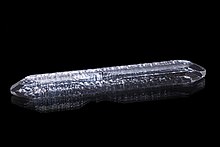
Back Hidrotermale metode Afrikaans سنتز گرمابی Persian 水熱合成 Japanese Гидротермалык процесстер Kirghiz Metoda hydrotermalna Polish Гидротермальный синтез Russian 水热合成法 Chinese

Hydrothermal synthesis includes the various techniques of crystallizing substances from high-temperature aqueous solutions at high vapor pressures; also termed "hydrothermal method". The term "hydrothermal" is of geologic origin.[1] Geochemists and mineralogists have studied hydrothermal phase equilibria since the beginning of the twentieth century. George W. Morey at the Carnegie Institution and later, Percy W. Bridgman at Harvard University did much of the work to lay the foundations necessary to containment of reactive media in the temperature and pressure range where most of the hydrothermal work is conducted.
Hydrothermal synthesis can be defined as a method of synthesis of single crystals that depends on the solubility of minerals in hot water under high pressure. The crystal growth is performed in an apparatus consisting of a steel pressure vessel called an autoclave, in which a nutrient is supplied along with water. A temperature gradient is maintained between the opposite ends of the growth chamber. At the hotter end the nutrient solute dissolves, while at the cooler end it is deposited on a seed crystal, growing the desired crystal.
Advantages of the hydrothermal method over other types of crystal growth include the ability to create crystalline phases which are not stable at the melting point. Also, materials which have a high vapour pressure near their melting points can be grown by the hydrothermal method. The method is also particularly suitable for the growth of large good-quality crystals while maintaining control over their composition. Disadvantages of the method include the need of expensive autoclaves, and the impossibility of observing the crystal as it grows if a steel tube is used.[2] There are autoclaves made out of thick walled glass, which can be used up to 300 °C and 10 bar.[3]
- ^ The earliest occurrence of the word "hydrothermal" appears to be: Sir Charles Lyell, A Manual of Elementary Geology … , 5th ed. (Boston, Massachusetts: Little, Brown, and Company, 1855), page 603: "The metamorphic theory [requires us to affirm] that an action, existing in the interior of the earth at an unknown depth, whether thermal, hydro-thermal, … "
- ^ O'Donoghue, M. (1983). A guide to Man-made Gemstones. Great Britain: Van Nostrand Reinhold Company. pp. 40–44. ISBN 0-442-27253-7.
- ^ Schubert, Ulrich. and Hüsing, Nicola. (2012) Synthesis of inorganic materials Weinheim: Wiley-VCH, page 161
